
Failing to learn proper technique as a beginner is one of the biggest mistakes many musicians make. Bad habits learned early can limit your performance and be hard to unlearn. And improperly holding a harmonica is no exception.
When I first started playing, I held the harmonica the way that seemed most comfortable. This did not go well. My poor grip on the instrument led to muted notes, difficulty controlling volume and even dropping the harmonica at times!
I ended up needing to reset and learn proper technique from the beginning. My goal here is to show you the correct harmonica holding techniques to help you avoid a similar fate.
Steps for properly holding a harmonica
These steps may feel a bit unnatural at first. But you’ll begin to see how important it is to hold the harp correctly as you play notes back and forth. Especially when you draw notes (inhaling through the harmonica) you’ll find a solid grasp keeps the instrument from moving too much—a problem that can lead to playing the wrong note.
The steps below were written with the assumption that the right hand is your dominant hand. Simply substitute left for right if you’re lefthanded. You may feel the need to adjust over time. But get comfortable with these techniques first.
1. Turn the harmonica lengthways so the numbers are on top.
This is the proper upright position for the instrument. For diatonic harmonicas, the numbers will range from “1” on the left side to “10” on the right side.
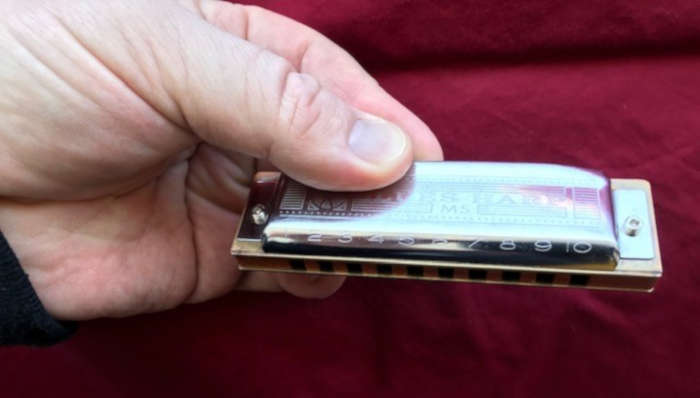
2. Form a C shape with your left hand and place the harmonica inside.
The side with hole number “1” should be furthest inside the C shape. Rest your forefinger across the top and far back so you can still see all the hole numbers. Grip the harmonica across the bottom with your thumb. Your left-hand forefinger shouldn’t be covering the numbers.
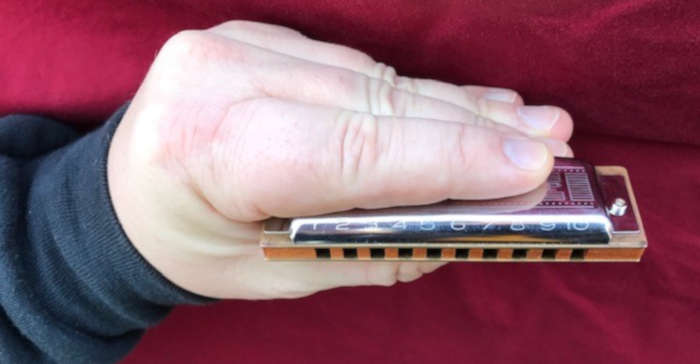
3. Place your middle left finger behind the harmonica.
You should now be holding the harp in the cup of your left hand with your middle finger supporting it in the back.
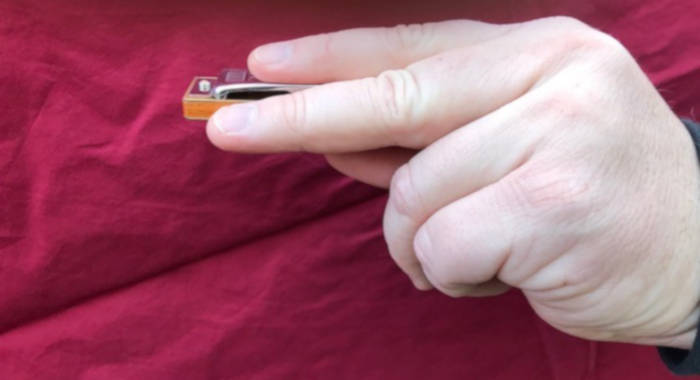
4. Turn your left ring and pinky fingers toward you under the harmonica, forming a cup shape.
This positioning will allow for a little more resonance when you play. It basically creates an extra sound chamber.
5. Bring your right hand under the harmonica.
Hold your right thumb against the right side of the harmonica for support. This will help keep the harmonica from slipping through as you move the harmonica back and forth to play it.
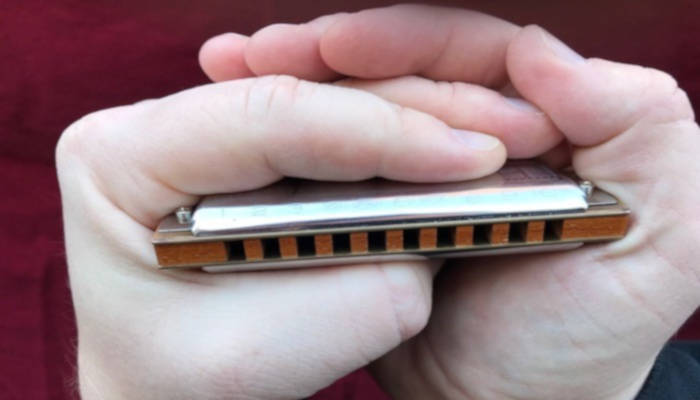
6. Wrap the fingers on your right hand over the fingers on your left.
You should now have a closed grip around the harp without fully covering it at the front end.
Make sure there isn’t any extra flesh from your hand blocking any of the holes and you can play each one with blowing and drawing air.
Changing your harmonica grip for tone and resonance
There are a couple ways you can vary your grip with your right, or dominant, hand that can be helpful as you become a more proficient harmonicist. Both are helpful to learn from the beginning.
A closed cup for lower tones and a muted effect
Cupping your right hand over the front of the harp and forming a seal with your left hand can create a muted or heavy-bass effect. This adds a character to your sound popular in some styles of play, especially blues.
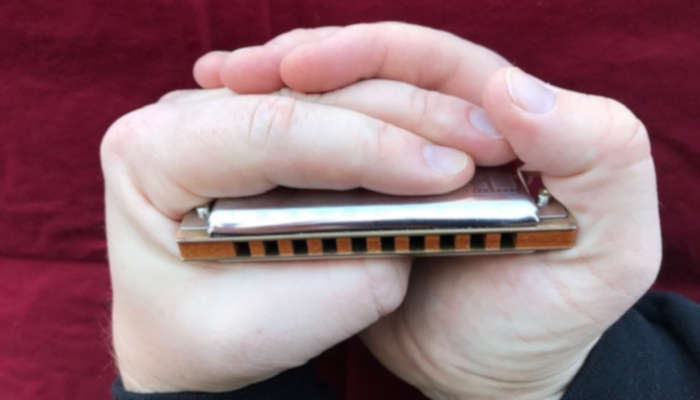
Open hands for higher tones and greater resonance
You can reach higher notes by drawing back the fingers on your left and right hand to open the front of the harmonica further. This holding technique also allows the sound to carry further from the harmonica.
Alternating between open hands and a closed-cup grip will give you a wah-wah type effect while playing.
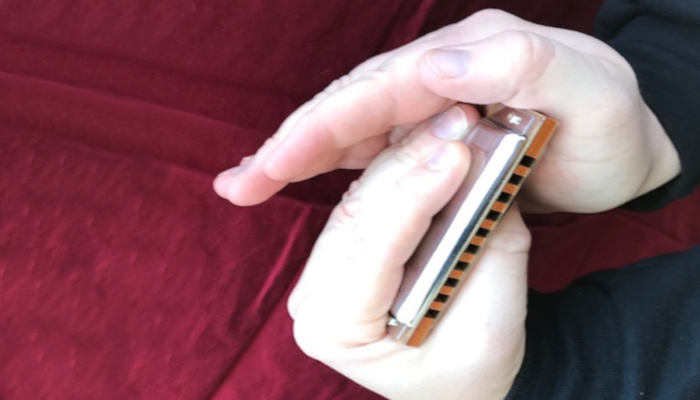
Common mistakes when holding a harmonica
A handful of common mistakes when holding a harp are often the cause of new musicians’ struggles to get the right sounds from their harps. Below are some of these mistakes to look out for and avoid in your own playing.
Playing with only one hand
Not only is this sloppy and lazy, but it also takes longer to switch between notes. Jumping from note to note, controlling volume and creating a wah-wah sound becomes much easier when you have both hands firmly gripping the instrument.
Trying to look at the harmonica while playing
You won’t be able to see most of the harmonica if you’re holding it properly. This why harmonica is sometimes called a blind instrument. You’re supposed to play it without seeing it.
Just as your fingers “learn” where the different keys are on a keyboard as you learn to type, your mouth will learn where the holes are on a harmonica. Your technique will suffer if you keep looking down to check progress. A proper grip will keep your eyes out of the equation, allowing you to focus on hearing and touch.
Moving your head instead of sliding the harmonica
We use a specific grip when holding the harp so that all the movements come from our hands and tongues. Our hands will shift the harp back and forth as needed and our tongues will take care of the rest of the movement. Your head should stay still!
Trying to jump ahead in skill without mastering proper holding technique
Don’t worry about vibrato, wah-wah and overblowing when first learning the harmonica. Focus on keeping a proper grip and letting your hands and mouth do all the work. Learn to play each numbered hole individually without moving your head and keep your ears trained so you never catch yourself looking down.
Holding a harmonica while using a microphone or other instrument
You may need to change the way your hold your harmonica if you’re using a microphone or playing a second instrument simultaneously. Not all the above advice becomes moot in such cases. But there are specific differences in technique to understand.
Playing into a microphone
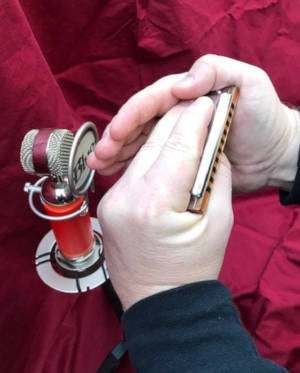
Mounting your microphone to a stand is the best way to record or amplify your harmonica sound without affecting your hold. Simply adjust the stand to match the height of your mouth.
Be sure to leave enough space between your harmonica and mic so your hands can move freely. You don’t want to knock over the mic and ruin an otherwise perfect performance!
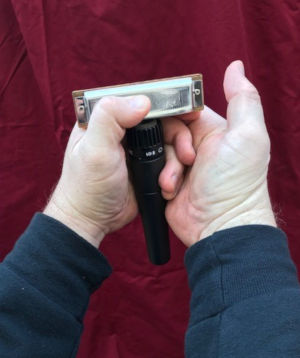
If you don’t have a microphone stand, try holding the mic cupped in your hand a couple inches away from your harmonica. The best way to manage this is to use your left ring and pinky fingers to hold the mic in this position. This allows your right hand to be used for extra mic support or for effects, depending on what you’re comfortable with.
Multitasking with a harmonica holder
You may want to play harmonica and a second instrument, like guitar, at the same time. You won’t be holding the harmonica with your hands in this case. You’ll instead need a harmonica holder or rack to hold the harmonica in place for you and free up your hands to play the second instrument.
These holders are placed around the neck and tightened with a screw, so they fit directly over the mouth. Some are made of metal, while others are padded for comfort.

Also, contrary to normal holding techniques, with a holder you’ll be moving your head instead of your hands. Be sure the holder is positioned correctly so you can easily move along all the tone holes. With correct tonguing techniques, you’ll find you can change notes while keeping head movement to a minimum.
I highly suggest beginners learn proper harmonica techniques, including how to hold a harmonica, before attempting to play a second instrument simultaneously. Take care of these basics before you work with harmonica holders.
Conclusion
Many musicians are self-taught these days. Many of us learn how to play thanks to blogs like this and online instructional videos. And while there’s nothing wrong with being an autodidact, it can lead to some very simple problems.
So, pay extra care to getting these techniques down early on in your harmonica journey. A proper grip on the harp allows for clean and smooth note changes. Knowing how to hold your harmonica properly will help you avoid the common mistakes that lead to stalled progress and frustration.
The harmonica is such a fun instrument to play, so let’s make sure you succeed!
Leave a Reply